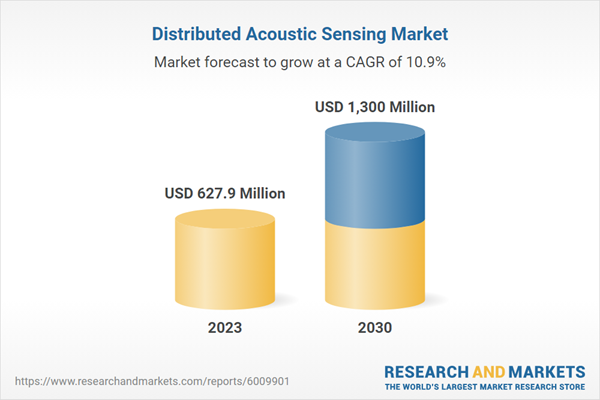The global distributed acoustic sensing market size is expected to reach USD 1.30 Billion in 2030 and is projected to grow at a CAGR of 10.9% from 2024 to 2030. The use of fiber optic sensors is progressively increasing in the oil and gas industry since they provide a data-rich perspective on micro-seismicity and fracturing process. Also, with the increasing importance of border surveillance, distributed acoustic sensing systems are being highly used in the security and surveillance industry since they provide high-reliability and low-cost surface crossing and tunnel construction detection. Due to the high potential of intrusion detection, the adoption of DAS systems is growing in several asset protection-related applications, such as railways, high-value facility perimeters, and oil and gas pipelines.
The economic benefits of distributed acoustic sensing are anticipated to create growth opportunities for the market in the forthcoming years. The key drivers include the prevention of construction damages and pipeline thefts. DAS systems can perform the early detection of leakages, corrosion, erosion, and malicious third-party intrusion, which offer economic benefits to the industry. Also, they provide real-time monitoring of assets and perimeters, which provides improved security. Therefore, distributed acoustic sensors are used in various end-user industries for long-distance tracking of the acoustic signals generated by external interferences.
The Asia Pacific distributed acoustic sensing market is expected to witness substantial growth over the forecast period, owing to the emerging trends, such as increasing penetration of seismology. According to the U.S. Energy Information Administration, the region accounted for approximately 10% of the world’s crude oil production in 2018. China alone contributed approximately 5% of global crude oil production in the same year. Due to the presence of substantial oil and gas industries, the region is expected to demonstrate significant growth in distributed acoustic sensing shortly.
This product will be delivered within 1-3 business days.
The economic benefits of distributed acoustic sensing are anticipated to create growth opportunities for the market in the forthcoming years. The key drivers include the prevention of construction damages and pipeline thefts. DAS systems can perform the early detection of leakages, corrosion, erosion, and malicious third-party intrusion, which offer economic benefits to the industry. Also, they provide real-time monitoring of assets and perimeters, which provides improved security. Therefore, distributed acoustic sensors are used in various end-user industries for long-distance tracking of the acoustic signals generated by external interferences.
The Asia Pacific distributed acoustic sensing market is expected to witness substantial growth over the forecast period, owing to the emerging trends, such as increasing penetration of seismology. According to the U.S. Energy Information Administration, the region accounted for approximately 10% of the world’s crude oil production in 2018. China alone contributed approximately 5% of global crude oil production in the same year. Due to the presence of substantial oil and gas industries, the region is expected to demonstrate significant growth in distributed acoustic sensing shortly.
Distributed Acoustic Sensing Market Report Highlights
- The significant surge in the deployment of optical fiber sensors in oil and gas industries will create a massive potential for the distributed acoustic sensing market
- Market players are focusing on providing optical fiber acoustic sensors for wellbores, which offers long-distance data transmission for subsea and downhole
- Key market players are considering partnerships and acquisitions of startups providing innovative products to expand their outreach in the market
- Canada distributed acoustic sensing (DAS) market is anticipated to witness the fastest growth in the North American region with a CAGR of 10.1% from 2024 to 2030.
The leading players in the Distributed Acoustic Sensing market include:
- OptaSense
- Halliburton
- SLB.
- Baker Hughes Company
- Future Fibre Technologies.
- Northrop Grumman.
- FOTECH
- Omnisens
- Silixa Ltd
- Ziebel Design
Why should you buy this report?
- Comprehensive Market Analysis: Gain detailed insights into the global market across major regions and segments.
- Competitive Landscape: Explore the market presence of key players worldwide.
- Future Trends: Discover the pivotal trends and drivers shaping the future of the global market.
- Actionable Recommendations: Utilize insights to uncover new revenue streams and guide strategic business decisions.
This report addresses:
- Market intelligence to enable effective decision-making
- Market estimates and forecasts from 2018 to 2030
- Growth opportunities and trend analyses
- Segment and regional revenue forecasts for market assessment
- Competition strategy and market share analysis
- Product innovation listing for you to stay ahead of the curve
- COVID-19's impact and how to sustain in these fast-evolving markets
This product will be delivered within 1-3 business days.
Table of Contents
Chapter 1. Methodology and Scope
Chapter 2. Executive Summary
Chapter 3. Global Distributed Acoustic Sensing (DAS) Market Variables, Trends, & Scope
Chapter 4. Consumer Behavior Analysis
Chapter 5. Global Distributed Acoustic Sensing (DAS) Market: Fiber Estimates & Trend Analysis
Chapter 6. Global Distributed Acoustic Sensing (DAS) Market: Vertical Estimates & Trend Analysis
Chapter 7. Global Distributed Acoustic Sensing (DAS) Market: Regional Estimates & Trend Analysis
Chapter 8. Competitive Landscape
Companies Mentioned
The leading players in the Distributed Acoustic Sensing market include:- OptaSense
- Halliburton
- SLB.
- Baker Hughes Company
- Future Fibre Technologies.
- Northrop Grumman.
- FOTECH
- Omnisens
- Silixa Ltd
- Ziebel Design
Methodology

LOADING...
Table Information
| Report Attribute | Details |
|---|---|
| No. of Pages | 100 |
| Published | September 2024 |
| Forecast Period | 2023 - 2030 |
| Estimated Market Value ( USD | $ 627.9 Million |
| Forecasted Market Value ( USD | $ 1300 Million |
| Compound Annual Growth Rate | 10.9% |
| Regions Covered | Global |
| No. of Companies Mentioned | 11 |









